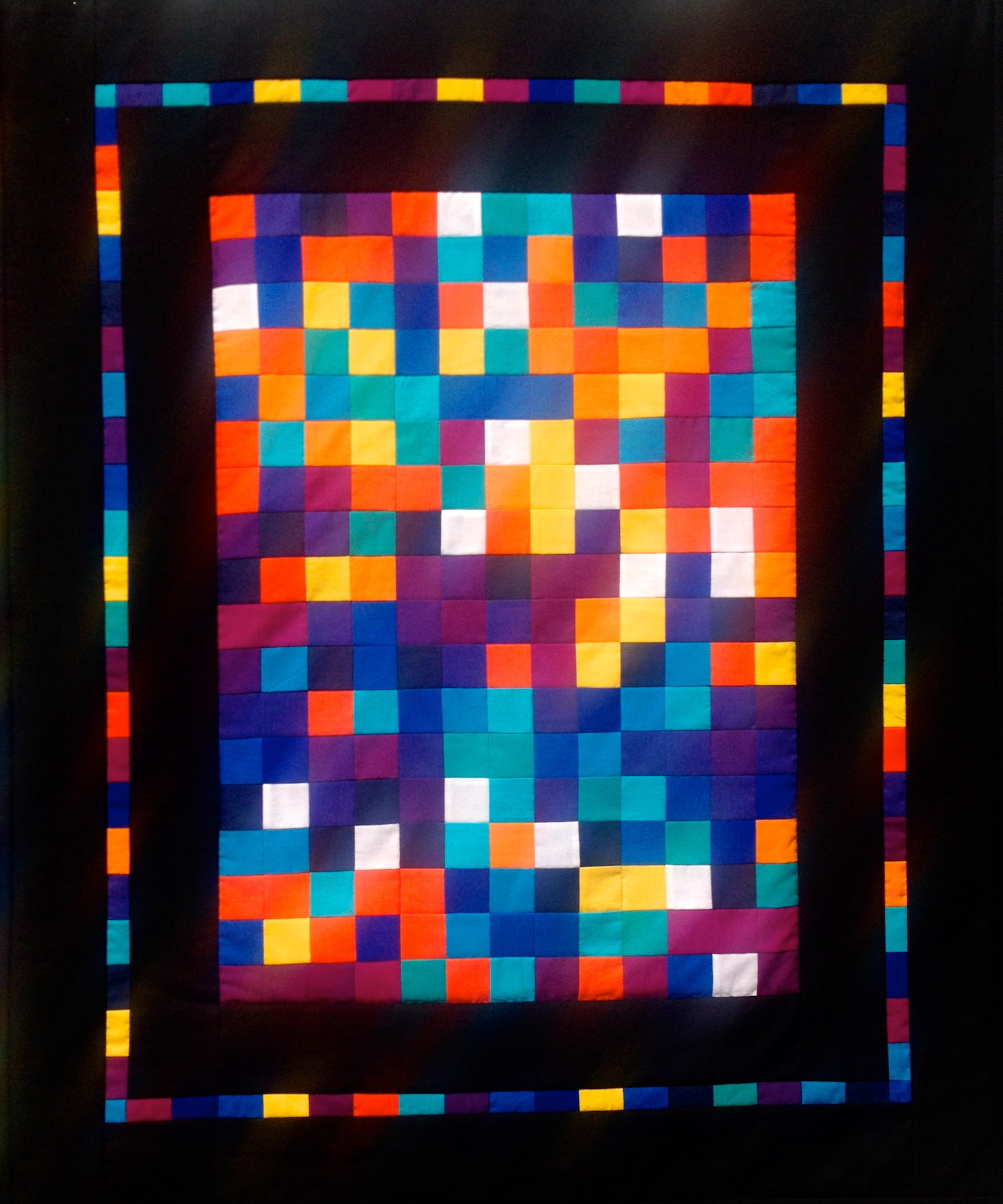Pi: 1
112cm square
2015
* 100% cotton fabric
* 100% cotton batting
* 100% cotton backing
* tie quilted
* hanging sleeve for a batten
* signed and dated on reverse
NFS
The piece above is the first in a series of experiments to find a visually exciting interpretation of that fascinating and powerful number, Pi. Such a potent and intriguing number must have an equally compelling visual interpretation. This is the starting point. Here Pi is represented to 440 decimal places.
Each digit is simply represented by a square in one colour, reading left to right on the top and alternate rows and reading right to left on even rows. Odd numbers are represented by warm colours and even numbers by cool colours. The sequence begins 3.141 etc.. This piece was created to see how the colours, in this seemingly random number, would cluster and form patterns.
Pi: 1b
58cm square
2018
* 100% cotton fabric
* 100% cotton batting
* calico backing
* tie quilted
* stretched on a canvas stretcher
* split batten wall fastening
* signed and dated on reverse
£1012
Above, another simple expression of that mysterious number, Pi. Made with just 10 colours, chosen for their contrasting tones, this piece differentiates between the prime numbers in Pi and the non-prime numbers. The non-primes are in blues and greens, and the primes are represented by white, red, orange and yellow. It is fascinating to see how the colours clump and form patterns within a seemingly random series of digits. The decimal point is represented by a button and the piece reads left to right in all rows, starting top left.
Four little slices of Pi
99cm square
2018
* 100% cotton fabric
* 100% cotton batting
* calico backing
* tie quilted
* 4 canvas stretchers
* mounted on fabric covered mdf
* split batten wall fastening
* signed and dated on reverse
NSF
Four little slices of Pi
99cm square
2018
NFS
Four different expressions of Pi - that fabulous number that enables us to do calculations with circles - are each stretched over a canvas frame, then mounted on a fabric covered backing board. Each have a decimal point represented by a button. The pieces all read left to right.
Pi: 3
113cm square
2016
* 100% cotton fabric
* 100% cotton batting
* 100% cotton backing
* hand quilted "in the ditch"
* flexible
* sleeve for hanging batten
* signed and dated on reverse
NFS
After the fun of Pi: 1, it seemed a logical step to introduce more colours and to experiment with triangles to add more visual interest. Pi: 3 uses 21 colours. The piece is 13 squares (26 triangles) across and down, each row using a sequence of the 21 colours. Over the whole piece, each number is represented by every colour, in strict mathematical rotation. All rows read left to right, from top left.
Pi: 3
detail
Pi: 4
89cm square
2018
Sold to The International Quilt Museum, Lincoln, Nebraska
18 colours and white are used to represent Pi. The colours are assigned to ensure that no two triangles of the same colour appear next to each other in any horizontal row. Using white, or a very pale neutral, increases the vibrancy of the work. A shade of white is used to indicate the digit "0" throughout. A button represents the decimal point and each line in the piece reads left to right.
Pi: 4
89cm square
2018
Sold
(Above, Pi: 4 has been photographed in a mirror, so you are seeing a reflection of the work.)
PI: 4
detail
Pi: prime
93cm square
2018
* 100% cotton fabric
* 100% cotton batting
* 100% cotton backing
* tie quilted
* flexible
* sleeve for hanging batten
* signed and dated on reverse
NFS
Above, black, grey and white with one colour are used to represent Pi from the decimal point. Black represents composite numbers (4, 6, 8, 9), white represents the prime numbers (2, 3, 5, 7), grey represents "1" (which is not a composite or a prime, and pink is zero). It reads from the top left corner, from the decimal point of Pi ie .1415926535…
Pi: plotting 7
87cm x 106cm
2017
* 100% cotton fabric
* 100% cotton batting
* 100% cotton backing
* tie quilted
* flexible
* sleeve for hanging batten
* signed and dated on reverse
NFS
Some 544 decimal places into Pi, there is an interesting occurrence of that wonderful number, seven (in classical literature the indication of completeness and wholeness). Starting top left and reading left to right in all rows, a section of Pi is depicted. Sequences of 14 colours are rotated for all the digits, except for the digit 7, which is represented by the brightest orange. This gives us the opportunity to see how 7 occurs in this section of Pi (see how infrequently 7 occurs in the third quarter of the piece compared to the top half and very bottom, where, suddenly, we see four occurrences of 7 in five digits.)
Pi
Many of us remember pi (π) from our schooldays – we used it to measure circles. This unfathomable number was known by Archimedes as early as the 3rd century BC and has intrigued mathematician ever since. They have worked it out to at least 2 quadrillion decimal places – and have still not reached the end of it!
It appears to be random, yet the sequence 999999 occurs after 762 decimal places, and again after 193,034 decimal places. Why? After 17,387,594,880 decimal places the sequence 0123456789 comes along. Why is this? What other secrets does pi hide? Is the sequence of digits actually random? And can we ever know for sure? Some even believe that when pi is uncovered to quadrillions more decimal places the only digits present will be 0 and 1. Will we ever know?










